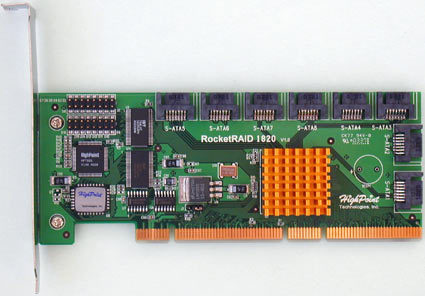RAIDCore Unleashes SATA to Take Out SCSI
HighPoint RocketRAID 1820
Firmware: 1.0
The RocketRAID 1820 is currently HighPoint's top model. In contrast to 3Ware's and RAIDCore's host adapters, the RocketRAID does not have its own cache memory. A PCI X interface for operating at up to 133 MHz is used here, too. This makes it clear what this controller's preferred applications are: Everything that needs a lot of bandwidth is more than welcome.
All Windows versions from Windows 98 and NT 4.0 are supported; Windows Server 2003 is mentioned on the installation disks, but there is no folder for it. But don't panic: Windows XP drivers are also suitable for 2003.
While we're on the subject of floppies, it should be mentioned that many of today's system no longer have a disk drive. The controller could only be operated after copying the HighPoint driver to a file server via a notebook.
Juggling the disks will become unpleasant if one of them breaks. In this case, the HighPoint website comes up with nothing - we found no trace of Windows drivers there. All it had were Linux driver updates. An extra CD with drivers and software would at least bump up the scope of delivery.
Like Adaptec and LSI, HighPoint allows you to protect access to the configuration software with a password. Adaptec solves this best by enabling complete access only to a Windows user with administrator rights, while HighPoint has its own user administration. It's no less safe but is somewhat more difficult to manage.
In our tests, the RocketRAID 1820 delivered decent transfer performance. The lack of a hardware XOR unit becomes noticeable when running the application benchmark in Winbench 99 2.0. HighPoint brings up the rear in this discipline. But, as already mentioned, it wasn't intended for this type of application. Reading on the go in RAID 5 at 220 to 172 MB/s is a good result. The 1820 is only beaten by the RAIDCore RC4852, which offers even better performance. The breakdown of performance in case of a hard drive defect is, however, critical (see diagram below).
Get Tom's Hardware's best news and in-depth reviews, straight to your inbox.
Current page: HighPoint RocketRAID 1820
Prev Page 3Ware Escalade 8506: BIOS And Configuration Next Page HighPoint RocketRAID 1820, Continued
Patrick Schmid was the editor-in-chief for Tom's Hardware from 2005 to 2006. He wrote numerous articles on a wide range of hardware topics, including storage, CPUs, and system builds.
